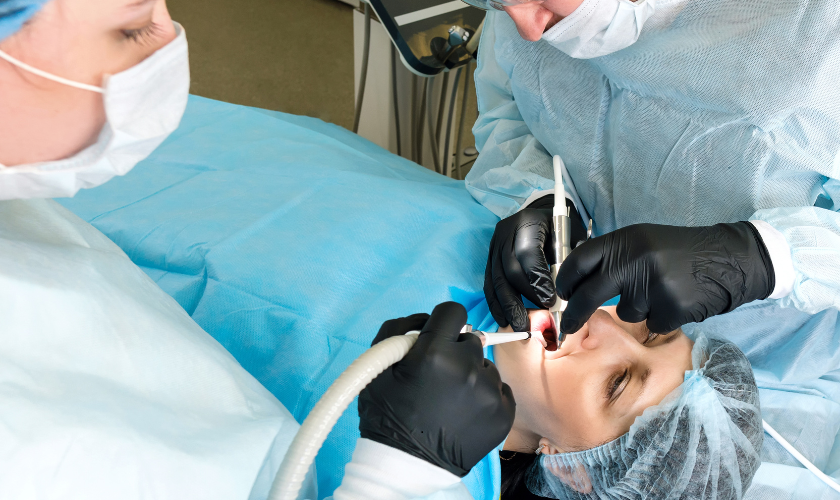943 Finchley Rd, London NW11 7PE
Don’t Let Dental Anxiety Hold You Back: Exploring Safe and Effective Sedation Options

Are you letting dental anxiety prevent you from seeking essential dental care? Sedation dentistry offers safe and effective solutions to help you overcome your fears and receive the treatment you need. A qualified sedation dentist uses various sedation techniques to ensure a comfortable and stress-free dental experience.
Dental anxiety, characterised by fear or apprehension about dental visits, can lead to avoidance of necessary treatments, impacting your oral health. However, with sedation dentistry, you can address your concerns and undergo procedures with confidence. By exploring different sedation options, such as oral sedation, inhalation sedation (nitrous oxide), IV sedation, and general anaesthesia, individuals can tailor their approach to suit their specific needs.
This blog will delve into each sedation method, highlighting its benefits, considerations, and suitability for various anxiety levels. Before delving into the specifics of each sedation technique, let’s explore the fundamental principles and types of sedation dentistry available.
Understanding Sedation Dentistry
Sedation dentistry involves the use of medication to help patients relax during dental procedures. It’s particularly beneficial for individuals with dental anxiety or phobia, as well as those undergoing extensive treatments. Here’s an overview of sedation dentistry:
Definition
Sedation dentistry, also known as sleep dentistry or conscious sedation, employs various medications to induce a state of relaxation and reduce anxiety during dental procedures.
Types of Sedation Techniques:
- Oral Sedation: Patients take prescribed medication orally before the appointment to induce relaxation.
- Inhalation Sedation (Nitrous Oxide): Also known as laughing gas, it’s administered through a mask over the nose, providing relaxation and reducing discomfort.
- IV Sedation: Medication is administered intravenously, allowing for deeper sedation levels while still maintaining consciousness.
- General Anesthesia: Reserved for extensive procedures or patients with severe anxiety; it involves inducing a state of unconsciousness.
Benefits of Sedation Dentistry:
- Anxiety Reduction: Sedation helps alleviate fear and anxiety associated with dental visits, making it easier for patients to undergo treatment.
- Increased Comfort: Patients experience reduced discomfort and pain during procedures, enhancing their overall dental experience.
- Improved Treatment Compliance: By making dental visits more manageable and comfortable, sedation dentistry encourages patients to attend regular appointments and complete necessary treatments, ultimately improving their oral health.
- Time Efficiency: Sedation allows dentists to perform complex procedures more efficiently, reducing the need for multiple appointments and minimising patient discomfort.
Sedation dentistry provides a viable solution for individuals struggling with dental anxiety or undergoing extensive dental work. Understanding the different sedation techniques and their benefits can help patients make informed decisions about their dental care, ensuring a more comfortable and stress-free experience at the dentist’s office.
Oral Sedation: A Gentle Approach
Oral sedation offers a gentle and convenient approach to managing dental anxiety and fear. Here’s what you need to know about this sedation technique:
- Definition: Oral sedation involves taking prescribed medication by mouth before the dental appointment to induce a state of relaxation and alleviate anxiety.
- Mechanism of Action: Oral sedatives typically belong to the benzodiazepine family and work by enhancing the effects of gamma-aminobutyric acid (GABA), a neurotransmitter that calms the central nervous system. This results in reduced anxiety and promotes relaxation.
- Administration: Patients are typically instructed to take the prescribed medication about an hour before their dental procedure. The dosage is tailored to each individual’s needs and level of anxiety.
- Effects: Oral sedation produces a calming effect, helping patients feel more comfortable and at ease during their dental visit. While patients remain conscious, they may feel tired or dizzy, making it essential to arrange for transportation to and from the appointment.
- Safety Considerations: While oral sedation is generally safe when administered by a qualified dental professional, it’s crucial to follow the dentist’s instructions regarding medication dosage and timing. Patients should disclose their complete medical history, including any allergies or current medications, to ensure safety and effectiveness.
- Precautions: Patients should avoid driving or operating heavy machinery for several hours after taking oral sedatives due to potential drowsiness. Additionally, arranging for a responsible adult to accompany them home is recommended.
Oral sedation provides an effective and comfortable option for patients who experience dental anxiety or phobia. By understanding how oral sedatives work and following safety precautions, individuals can undergo dental treatment with increased ease and confidence.
Inhalation Sedation (Nitrous Oxide): The Relaxing Gas
Nitrous oxide, also known as laughing gas, is a popular form of inhalation sedation used in dentistry to help patients relax during dental procedures. Here’s what you need to know about nitrous oxide sedation:
- Introduction: Nitrous oxide is a colourless and odourless gas administered through a mask placed over the patient’s nose. It’s mixed with oxygen and inhaled by the patient, inducing a sense of calmness and relaxation without putting them to sleep.
- Experience: Patients typically experience feelings of euphoria and detachment from their surroundings shortly after inhaling nitrous oxide. The soothing effect allows patients to remain conscious and responsive throughout the dental procedure while feeling more comfortable and less anxious.
- Advantages: Nitrous oxide sedation offers several advantages, including rapid onset and recovery times, making it suitable for short dental procedures. The dentist can easily adjust it to achieve the desired level of sedation, and its effects wear off quickly once the gas is discontinued, allowing patients to resume their daily activities without lingering drowsiness.
- Limitations: While nitrous oxide is considered safe for most patients, it may not be suitable for individuals with certain medical conditions or respiratory issues. Additionally, some patients may not experience the desired level of sedation with nitrous oxide alone, requiring alternative sedation options for more significant anxiety or fear.
Nitrous oxide sedation provides a safe and effective means of relaxation for patients undergoing dental treatment. Its fast-acting properties and minimal side effects make it a valuable tool for helping patients with dental anxiety feel more at ease during their appointments.
IV Sedation: Deeper Relaxation Under Supervision
Intravenous (IV) sedation is a method of administering sedative medication directly into the bloodstream to induce a deep state of relaxation and comfort during dental procedures. Here’s a closer look at IV sedation:
- Description: IV sedation involves the use of a needle inserted into a vein, typically in the patient’s arm or hand, to deliver sedative drugs directly into the bloodstream. This allows for rapid onset and precise control over the level of sedation throughout the dental procedure.
- Administration Process: Before the dental procedure begins, a qualified dentist or anesthesiologist will carefully insert the IV line and monitor the patient’s vital signs throughout the sedation process. The sedative medications used in IV sedation produce a calming effect, often causing patients to feel drowsy or even fall asleep during the procedure.
- Effects: IV sedation induces a state of deep relaxation, making it an effective option for patients with severe dental anxiety or those undergoing complex dental treatments. While patients remain conscious and able to respond to verbal cues, they may have little to no memory of the procedure afterwards.
- Recommendations: IV sedation may be recommended for patients undergoing lengthy or invasive dental procedures, those with extreme dental phobia, or individuals with special needs who may have difficulty remaining still during treatment. It allows patients to receive the dental care they need comfortably and without fear or discomfort.
IV sedation offers a safe and effective solution for patients who require deeper relaxation during dental procedures. Careful monitoring and proper administration allow patients to undergo treatment with minimal anxiety and discomfort.
General Anesthesia: Last Resort for Severe Anxiety
General anaesthesia is a deep state of unconsciousness induced by administering medication that makes patients completely unaware and unresponsive during dental procedures. Here’s what you need to know about general anaesthesia in dentistry:
- Explanation: General anaesthesia involves the use of powerful medications to render the patient unconscious and unresponsive to pain stimuli. It is typically reserved for complex or invasive dental procedures where other forms of sedation may not provide adequate relaxation or pain control.
- Necessity: General anaesthesia may be necessary in cases where the patient has severe dental anxiety or phobia, requires extensive oral surgery, or has medical conditions that make it unsafe to remain conscious during the procedure. It allows dentists to perform treatment safely and efficiently while ensuring the patient’s comfort.
- Risks: While general anaesthesia is generally safe when administered by qualified professionals in a controlled environment, it carries inherent risks, including allergic reactions, respiratory depression, and cardiovascular complications. Patients undergoing general anaesthesia must undergo a thorough pre-operative evaluation to assess their overall health and suitability for anaesthesia.
- Considerations: Dentists and oral surgeons carefully weigh the benefits and risks of general anaesthesia for each patient, taking into account factors such as medical history, age, and the complexity of the dental procedure. Patients considering general anaesthesia should discuss their concerns and preferences with their dentist to make informed decisions about their treatment plans.
Choosing the Right Sedation Option for You
Choosing the right sedation option for dental treatment is crucial for ensuring a comfortable and stress-free experience. Here are some factors to consider when selecting a sedation method:
- Medical History: Your overall health and medical history can impact the sedation option. Inform your dentist about any medical conditions or medications.
- Level of Anxiety: Severe anxiety may require deeper sedation like IV sedation or general anaesthesia. Mild anxiety might only need nitrous oxide or oral sedation.
- Procedure Complexity: Simple procedures might need only light sedation, while more complex treatments may require stronger sedatives for comfort.
- Cost and Insurance: Check your budget and insurance coverage for sedation services. Discuss pricing with your dentist.
- Personal Preferences: Choose sedation based on your comfort. Some prefer quick recovery with nitrous oxide, while others might opt for deeper sedation.
During your consultation with a sedation dentist, you’ll have the opportunity to discuss these factors and determine the most appropriate sedation option for your needs. Your dentist will conduct a thorough evaluation and tailor the sedation approach to ensure your safety, comfort, and overall satisfaction with the dental experience.
The Ultimate Solution for Nervous Patients
Sedation dentistry offers a lifeline for those battling dental anxiety, ensuring a relaxed and stress-free experience. By understanding the various sedation options available and considering individual needs, patients can confidently undergo dental procedures without fear or discomfort. If you’re ready to take the next step towards overcoming dental anxiety, schedule a consultation with our Golders Green dentist at Lotus Dental And Aesthetics Clinic today and discover how sedation dentistry can transform your dental experience.




